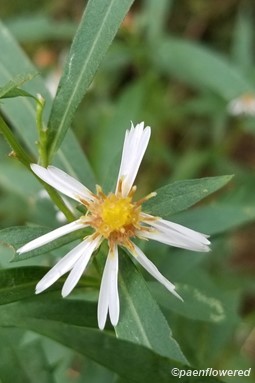Symphyotrichum lanceolatum
White-flowered native aster with long lanceolate leaves
Symphyotrichum lanceolatum lanceleaf aster
Add to MyPlants View Locations
This tall, small-flowered native aster is found in much of North America except for the far north. It is now a common sight growing in a variety of man-disturbed habitats. The leaves of this perennial aster are slender, short-stalked, sharp-pointed and hairless. They are either toothless or with only a few teeth and have blunt bases.
This species is most easily identified by the abundant white ray flowers (petals)—20-40 per flower head. Each flower head is ½ to ¾ inch in diameter. The central disk flowers are yellow and turn pinkish with age. The flower bracts are narrow and green tipped. The blooming period is August to October. The flowers attract a variety of insects, especially bees, flies and wasps.
The main stem is grooved and branches occasionally. The stems also have lines of white hairs. Often there are groups of small leaves where the stem branches. The fruit is a dry and seed-like achene and is tipped with tufts of hair to aid wind distribution. The new stems are green in color, but turn brown and woody with age, especially in the larger plants. These older, woody stems are smooth. This aster can grow up to 8 feet tall depending on growing conditions.
This species may form colonies by spreading from underground rhizomes and can be quite showy. In many areas, however, it is treated as a weed, especially if growing in an agricultural setting.
Habitat & Range
Common in old fields, open woods, and roadsides.
Present throughout the state.
| EMP: | FACW |
|---|---|
| NCNE: | FACW |
Phenology
Flowers late September to early November.
Characteristics
Flowers flowerheads in branching clusters at the top of the stem arising from upper leaf axils. Up to 20 flowers per branch. Sometimes flowers can be on one side of a branch. From 16 to 50 ray flowers, yellow center disk turns reddish with age. Rays are normally white, or could be blue to violet. Bracts are in 3 to 6 layers, lance-linear, green and pale at the base, hairy, outer layer shorter than the inner. Pedicels are variably hairy, could be in lines, with several leaf-like bracts below the flower.
Leaves thin, lance-linear, up to 4 in long; mostly toothless or just few widely-spaced teeth and glabrous except tiny hairs around the edge; pointed at the tip and without a pedicel. Basal leaves are broader with winged, sheathing stalks and vary in shape. Basal and lower stem leaves wither away by flowering time but continue to stay on the stem.
Stems erect, round or maybe shllowly grooved, mostly smooth except for lines of short hairs in the upper plant and into the flowering branches. May form colonies from long rhizomes.
Fruit dry seeds with a tuft of white or yellowish hairs, gets carried away by wind.
Identification Tips
The leaves of this aster are of distinct lanceolate shape. When dying the leaves curl up in a spiral.
Plant Codes
S-rank: S5 (Secure)
G-rank: G5 (Secure)
Symphyotrichum lanceolatum lanceleaf aster
Synonyms: Aster simplexAdd to MyPlants View Locations
Plant Summary
Common Names
Symphyotrichum






















Comments
Have you spotted this plant in your area? We'd love to hear about your experience! Share your comments or questions about the plant below. Comments are moderated before posting.